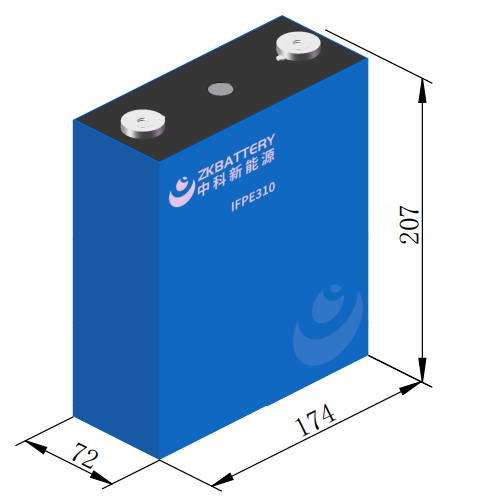Cylindrical, Prismatic and Polymer pack lithium battery structure features
Cylindrical
Prismatic and Polymer pack lithium battery structure features
Cylindrical lithium battery has many models, such as 14500, 18350, 18500, 18650, 21700, 26650, 32650, etc. Cylindrical lithium battery production process is mature, PACK cost is lower, battery product yield and the consistency of the battery pack is higher; due to the large heat dissipation area of the battery pack, its heat dissipation performance is better than that of the Prismatic cell batteries; Cylindrical batteries are easy to combine with various forms. Cylindrical batteries are convenient for a variety of combinations of forms, suitable for electric vehicle space design of the full layout. However, cylindrical batteries are generally encapsulated in steel or aluminum shells, which are relatively heavy and have a relatively low specific energy. At present, China, Japan, South Korea, the United States and other mature manufacturers, such as SANYO, SONY, LG, Wanxiang A123.
With the further expansion of the electric vehicle market and the continuous improvement of the requirements for range, vehicle manufacturers have put forward higher requirements for power batteries in terms of energy density, manufacturing cost, cycle life and additional product attributes. Under the premise that no great breakthroughs have been made in the field of raw materials, increasing the volume of cylindrical batteries to obtain more battery capacity has become a direction that can be explored.
Prismatic batteries: too many models, process unification is difficult
Prismatic cell shell is mostly aluminum alloy, stainless steel and other materials, the internal use of winding or stacking process, the protection of the battery cell is better than the aluminum-plastic film batteries (i.e., soft pack batteries), the safety of the battery cell relative to the cylindrical battery has also improved.
Lithium battery aluminum shells have been developed on the basis of steel shells. Compared with steel shells, the light weight and safety, as well as the resulting performance advantages, have made aluminum shells the mainstream of lithium battery housings. Lithium battery aluminum shells are still developing in the direction of high hardness and light weight technology, which will provide the market with more technically superior lithium battery products. At present, the production of prismatic battery companies are Guoxuan Gaoke, Samsung SDI, LiShen, CATL and so on.
Because prismatic lithium batteries can be customized according to the size of the product, so there are thousands of models on the market, and because there are too many models, the process is difficult to unify. Prismatic batteries in ordinary electronic products on the use of no problem, but for the need for a number of series, parallel connection of industrial equipment products, it is best to use standardized production of cylindrical lithium batteries, so that the production process is guaranteed, and it is easier to find replaceable batteries in the future.
Polymer batteries: the future market share is expected to exceed 50%
The key materials used in polymer lithium batteries - positive electrode materials, negative electrode materials and diaphragm - and the traditional steel shell, aluminum shell lithium batteries are not much difference, the biggest difference lies in the polymer materials (aluminum-plastic composite film), which is the most critical polymer lithium batteries, the most technically difficult material. Polymer packaging materials are usually divided into three layers, namely, the outer barrier layer (generally nylon BOPA or PET outer protective layer), permeability barrier layer (intermediate layer of aluminum foil) and the inner layer (multifunctional high-barrier layer).
Polymer battery packaging materials and structure so that it has a series of advantages, for example, good safety performance, polymer batteries in the structure of the aluminum-plastic film packaging, the occurrence of safety problems, polymer batteries will generally be bulging and cracked, not like steel or aluminum shell battery cell explosion; light weight, polymer batteries weight than the same capacity of lithium batteries with steel shells is 40% lighter than aluminum lithium batteries are 20% lighter; internal resistance is small, the internal resistance is smaller than lithium batteries. The internal resistance of polymer batteries is smaller than lithium batteries, which can greatly reduce the self-consumption of the battery; good cycling performance, polymer batteries have a longer cycle life, 100 cycle attenuation is 4% to 7% less than the aluminum shell; design flexibility, the shape of the shape can be changed to any shape, can be thinner, can be customized according to the needs of customers, the development of new models of battery cells.

The shortcomings of polymer batteries are poor consistency, high cost and susceptibility to leakage. The high cost can be solved by scale production, and the leakage can be solved by improving the quality of aluminum-plastic film.
In the digital field, consumer electronic products for battery requirements toward the small size, thin and light trend, polymer replacement of prismaticaluminum shell continues to accelerate the speed of polymer lithium polymer batteries, with its excellent overall performance, in smart phones, tablet PCs, wearable devices and other consumer electronics products are widely used, and the growth rate is far faster than the average of lithium battery industry.
 English
English
RV Power Battery PACK Solution
detailed description of the power battery PACK solution scheme for RV: 1. Battery type selection 2. Battery capacity and voltage 3. PACK structure design 4. Thermal management design 5. Safety design 6. Performance optimization
Read MoreLithium Iron Phosphate Battery Cycle Life and Factors Affecting Life
As a leader in lithium battery technology, lithium iron phosphate batteries are highly regarded for their excellent performance and long life.
Read MoreLithium Battery And Lead-Acid Battery Transport Un Number Description
Lithium battery packs are classified in Class 9 dangerous goods - miscellaneous dangerous substances, the United Nations number is UN3080, UN3081, UN3090, UN3091, and the transport packaging category is Class II
Read More